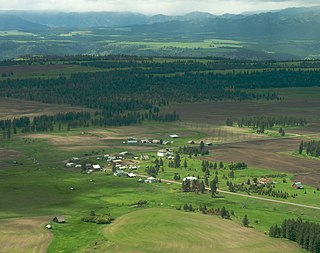
Bagielnica is a settlement in the administrative district of Gmina Szemud, within Wejherowo County, Pomeranian Voivodeship, in northern Poland. It lies approximately 11 kilometres (7 mi) south-west of Szemud, 22 km (14 mi) south-west of Wejherowo, and 34 km (21 mi) west of the regional capital Gdańsk.

Bożanka is a settlement in the administrative district of Gmina Szemud, within Wejherowo County, Pomeranian Voivodeship, in northern Poland. It lies approximately 7 kilometres (4 mi) east of Szemud, 16 km (10 mi) south of Wejherowo, and 24 km (15 mi) north-west of the regional capital Gdańsk.

Czarna Dąbrowa is a settlement in the administrative district of Gmina Szemud, within Wejherowo County, Pomeranian Voivodeship, in northern Poland. It lies approximately 3 kilometres (2 mi) north-west of Szemud, 11 km (7 mi) south of Wejherowo, and 32 km (20 mi) north-west of the regional capital Gdańsk.

Czarna Góra is a settlement in the administrative district of Gmina Szemud, within Wejherowo County, Pomeranian Voivodeship, in northern Poland. It lies approximately 9 kilometres (6 mi) east of Szemud, 16 km (10 mi) south-east of Wejherowo, and 22 km (14 mi) north-west of the regional capital Gdańsk.

Dębnik is a settlement in the administrative district of Gmina Szemud, within Wejherowo County, Pomeranian Voivodeship, in northern Poland. It lies approximately 4 kilometres (2 mi) south-east of Szemud, 15 km (9 mi) south of Wejherowo, and 27 km (17 mi) north-west of the regional capital Gdańsk.

Dobrzewino is a village in the administrative district of Gmina Szemud, within Wejherowo County, Pomeranian Voivodeship, in northern Poland. It lies approximately 12 kilometres (7 mi) east of Szemud, 19 km (12 mi) south-east of Wejherowo, and 19 km (12 mi) north-west of the regional capital Gdańsk.

Gapionka is a settlement in the administrative district of Gmina Szemud, within Wejherowo County, Pomeranian Voivodeship, in northern Poland. It lies approximately 6 kilometres (4 mi) south-west of Szemud, 18 km (11 mi) south of Wejherowo, and 30 km (19 mi) west of the regional capital Gdańsk.

Kamień is a village in the administrative district of Gmina Szemud, within Wejherowo County, Pomeranian Voivodeship, in northern Poland. It lies approximately 4 kilometres (2 mi) east of Szemud, 14 km (9 mi) south of Wejherowo, and 27 km (17 mi) north-west of the regional capital Gdańsk.

Karczemki is a village in the administrative district of Gmina Szemud, within Wejherowo County, Pomeranian Voivodeship, in northern Poland. It lies approximately 12 kilometres (7 mi) south-east of Szemud, 20 km (12 mi) south-east of Wejherowo, and 19 km (12 mi) north-west of the regional capital Gdańsk.

Kieleńska Huta is a village in the administrative district of Gmina Szemud, within Wejherowo County, Pomeranian Voivodeship, in northern Poland. It lies approximately 5 kilometres (3 mi) south-east of Szemud, 16 km (10 mi) south of Wejherowo, and 25 km (16 mi) north-west of the regional capital Gdańsk.

Koleczkowo is a village in the administrative district of Gmina Szemud, within Wejherowo County, Pomeranian Voivodeship, in northern Poland. It lies approximately 8 kilometres (5 mi) east of Szemud, 14 km (9 mi) south-east of Wejherowo, and 24 km (15 mi) north-west of the regional capital Gdańsk.

Kowalewo is a village in the administrative district of Gmina Szemud, within Wejherowo County, Pomeranian Voivodeship, in northern Poland. It lies approximately 7 kilometres (4 mi) south of Szemud, 19 km (12 mi) south of Wejherowo, and 26 km (16 mi) west of the regional capital Gdańsk.

Łekno is a settlement in the administrative district of Gmina Szemud, within Wejherowo County, Pomeranian Voivodeship, in northern Poland. It lies approximately 5 kilometres (3 mi) south-east of Szemud, 16 km (10 mi) south of Wejherowo, and 26 km (16 mi) north-west of the regional capital Gdańsk.

Leśno is a village in the administrative district of Gmina Szemud, within Wejherowo County, Pomeranian Voivodeship, in northern Poland. It lies approximately 7 kilometres (4 mi) south-east of Szemud, 18 km (11 mi) south of Wejherowo, and 24 km (15 mi) west of the regional capital Gdańsk.

Moczydła is a settlement in the administrative district of Gmina Szemud, within Wejherowo County, Pomeranian Voivodeship, in northern Poland. It lies approximately 3 kilometres (2 mi) south-east of Szemud, 15 km (9 mi) south of Wejherowo, and 28 km (17 mi) north-west of the regional capital Gdańsk.

Nowa Karczma is a village in the administrative district of Gmina Szemud, within Wejherowo County, Pomeranian Voivodeship, in northern Poland. It lies approximately 4 kilometres (2 mi) south-east of Szemud, 16 km (10 mi) south of Wejherowo, and 27 km (17 mi) north-west of the regional capital Gdańsk.

Przetoczyno is a village in the administrative district of Gmina Szemud, within Wejherowo County, Pomeranian Voivodeship, in northern Poland. It lies approximately 5 kilometres (3 mi) north of Szemud, 10 km (6 mi) south of Wejherowo, and 33 km (21 mi) north-west of the regional capital Gdańsk.

Szopa is a village in the administrative district of Gmina Szemud, within Wejherowo County, Pomeranian Voivodeship, in northern Poland. It lies approximately 8 kilometres (5 mi) south-west of Szemud, 20 km (12 mi) south of Wejherowo, and 33 km (21 mi) west of the regional capital Gdańsk.

Warzno is a village in the administrative district of Gmina Szemud, within Wejherowo County, Pomeranian Voivodeship, in northern Poland. It lies approximately 10 kilometres (6 mi) south-east of Szemud, 19 km (12 mi) south of Wejherowo, and 21 km (13 mi) north-west of the regional capital Gdańsk.

Zęblewski Młyn is a settlement in the administrative district of Gmina Szemud, within Wejherowo County, Pomeranian Voivodeship, in northern Poland. It lies approximately 9 kilometres (6 mi) west of Szemud, 18 km (11 mi) south-west of Wejherowo, and 37 km (23 mi) west of the regional capital Gdańsk.






